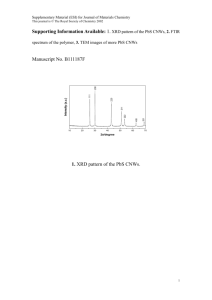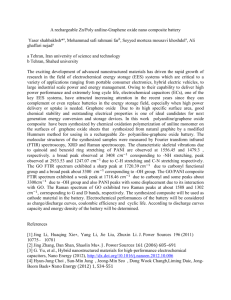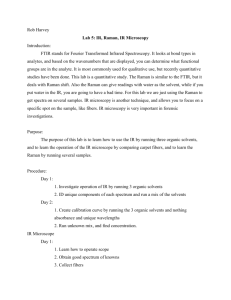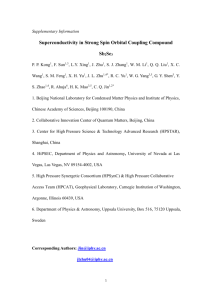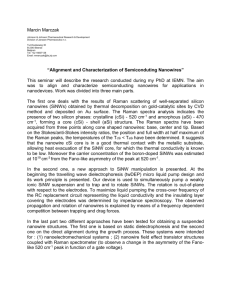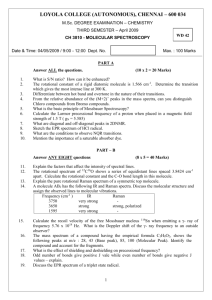Document 13308587
advertisement
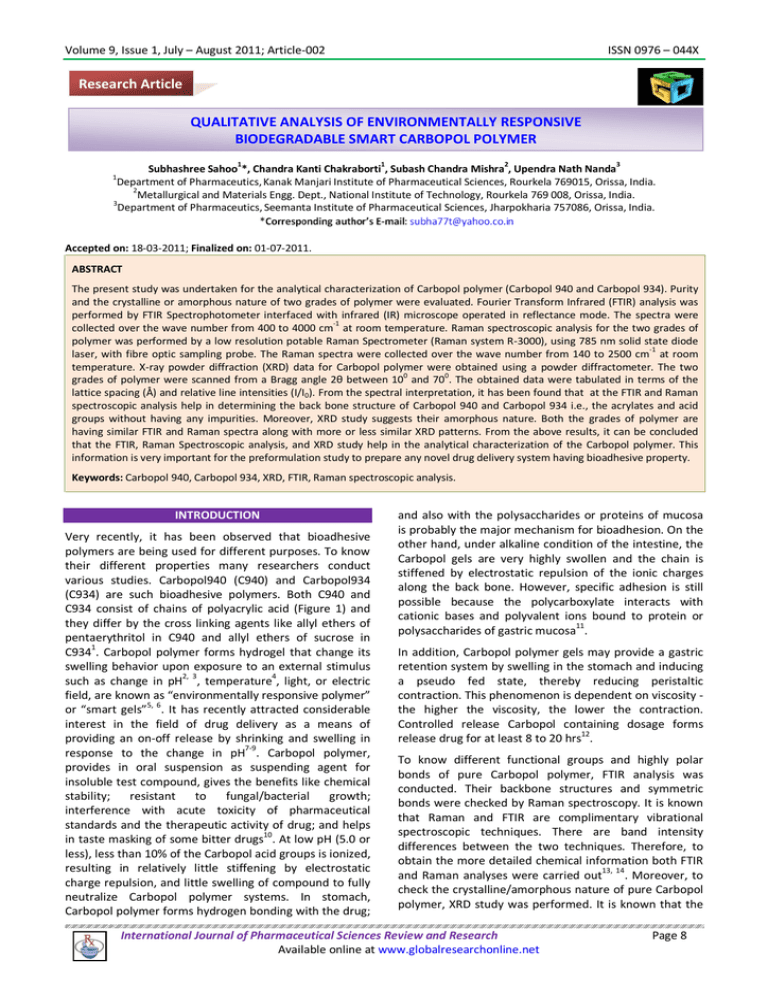
Volume 9, Issue 1, July – August 2011; Article-002 ISSN 0976 – 044X Research Article QUALITATIVE ANALYSIS OF ENVIRONMENTALLY RESPONSIVE BIODEGRADABLE SMART CARBOPOL POLYMER 1 1 2 3 Subhashree Sahoo *, Chandra Kanti Chakraborti , Subash Chandra Mishra , Upendra Nath Nanda Department of Pharmaceutics, Kanak Manjari Institute of Pharmaceutical Sciences, Rourkela 769015, Orissa, India. 2 Metallurgical and Materials Engg. Dept., National Institute of Technology, Rourkela 769 008, Orissa, India. 3 Department of Pharmaceutics, Seemanta Institute of Pharmaceutical Sciences, Jharpokharia 757086, Orissa, India. 1 Accepted on: 18-03-2011; Finalized on: 01-07-2011. ABSTRACT The present study was undertaken for the analytical characterization of Carbopol polymer (Carbopol 940 and Carbopol 934). Purity and the crystalline or amorphous nature of two grades of polymer were evaluated. Fourier Transform Infrared (FTIR) analysis was performed by FTIR Spectrophotometer interfaced with infrared (IR) microscope operated in reflectance mode. The spectra were -1 collected over the wave number from 400 to 4000 cm at room temperature. Raman spectroscopic analysis for the two grades of polymer was performed by a low resolution potable Raman Spectrometer (Raman system R-3000), using 785 nm solid state diode -1 laser, with fibre optic sampling probe. The Raman spectra were collected over the wave number from 140 to 2500 cm at room temperature. X-ray powder diffraction (XRD) data for Carbopol polymer were obtained using a powder diffractometer. The two 0 0 grades of polymer were scanned from a Bragg angle 2θ between 10 and 70 . The obtained data were tabulated in terms of the lattice spacing (Å) and relative line intensities (I/I0). From the spectral interpretation, it has been found that at the FTIR and Raman spectroscopic analysis help in determining the back bone structure of Carbopol 940 and Carbopol 934 i.e., the acrylates and acid groups without having any impurities. Moreover, XRD study suggests their amorphous nature. Both the grades of polymer are having similar FTIR and Raman spectra along with more or less similar XRD patterns. From the above results, it can be concluded that the FTIR, Raman Spectroscopic analysis, and XRD study help in the analytical characterization of the Carbopol polymer. This information is very important for the preformulation study to prepare any novel drug delivery system having bioadhesive property. Keywords: Carbopol 940, Carbopol 934, XRD, FTIR, Raman spectroscopic analysis. INTRODUCTION Very recently, it has been observed that bioadhesive polymers are being used for different purposes. To know their different properties many researchers conduct various studies. Carbopol940 (C940) and Carbopol934 (C934) are such bioadhesive polymers. Both C940 and C934 consist of chains of polyacrylic acid (Figure 1) and they differ by the cross linking agents like allyl ethers of pentaerythritol in C940 and allyl ethers of sucrose in 1 C934 . Carbopol polymer forms hydrogel that change its swelling behavior upon exposure to an external stimulus 2, 3 4 such as change in pH , temperature , light, or electric field, are known as “environmentally responsive polymer” or “smart gels”5, 6. It has recently attracted considerable interest in the field of drug delivery as a means of providing an on-off release by shrinking and swelling in 7-9 response to the change in pH . Carbopol polymer, provides in oral suspension as suspending agent for insoluble test compound, gives the benefits like chemical stability; resistant to fungal/bacterial growth; interference with acute toxicity of pharmaceutical standards and the therapeutic activity of drug; and helps in taste masking of some bitter drugs10. At low pH (5.0 or less), less than 10% of the Carbopol acid groups is ionized, resulting in relatively little stiffening by electrostatic charge repulsion, and little swelling of compound to fully neutralize Carbopol polymer systems. In stomach, Carbopol polymer forms hydrogen bonding with the drug; and also with the polysaccharides or proteins of mucosa is probably the major mechanism for bioadhesion. On the other hand, under alkaline condition of the intestine, the Carbopol gels are very highly swollen and the chain is stiffened by electrostatic repulsion of the ionic charges along the back bone. However, specific adhesion is still possible because the polycarboxylate interacts with cationic bases and polyvalent ions bound to protein or 11 polysaccharides of gastric mucosa . In addition, Carbopol polymer gels may provide a gastric retention system by swelling in the stomach and inducing a pseudo fed state, thereby reducing peristaltic contraction. This phenomenon is dependent on viscosity the higher the viscosity, the lower the contraction. Controlled release Carbopol containing dosage forms 12 release drug for at least 8 to 20 hrs . To know different functional groups and highly polar bonds of pure Carbopol polymer, FTIR analysis was conducted. Their backbone structures and symmetric bonds were checked by Raman spectroscopy. It is known that Raman and FTIR are complimentary vibrational spectroscopic techniques. There are band intensity differences between the two techniques. Therefore, to obtain the more detailed chemical information both FTIR 13, 14 and Raman analyses were carried out . Moreover, to check the crystalline/amorphous nature of pure Carbopol polymer, XRD study was performed. It is known that the International Journal of Pharmaceutical Sciences Review and Research Available online at www.globalresearchonline.net Page 8 Volume 9, Issue 1, July – August 2011; Article-002 identification of a structure from its powdered diffraction pattern is based upon the position of peaks and their relative intensities. Each XRD pattern is characterized by the interplanar d-spacing and the relative intensities 15 (I/I0) . Nevertheless, complete diffraction patterns are still characteristics of the samples. Considering all the reasons, the qualitative analysis of Carbopol940 and Carbopol934 was performed by FTIR, Raman Spectroscopy and X-Ray diffractometry. This study is very important before incorporating the above mentioned polymer into the novel drug delivery systems. MATERIALS AND METHODS Materials Carbopol 940 and Carbopol 934 were supplied by Cosmo Chem. Laboratory, Pune, India. ISSN 0976 – 044X 1.54056 Å as the radiation source. Each powdered specimen was packed in a specimen holder made of glass. In setting up the specimen and apparatus, co planarity of the specimen surface with the specimen holder surface, and the setting of the specimen holder at the position of symmetric reflection geometry were ensured. The powders were passed through a 100 mesh sieve and were placed into the sample holder by the side drift technique16. The holder consisted of a central cavity. In order to prepare a sample for analysis, a glass slide was clipped to the top face of the sample holder so as to form a wall. The powder sample was filled into the holder, gently tapped and used for XRD measurement.10 mg of each sample was scanned at 25°C from 10˚ to 70˚ (2θ) and in step size of 0.020 and count time of 2.00 s, using an automatic divergence slit assembly and a proportional detector. Relative intensities were read from the strip charts and corrected to fixed slit values. Methods OH Fourier Transform Infrared (FTIR) Spectroscopy FTIR analysis was performed with an FTIR spectrophotometer interfaced with an infrared (IR) microscope operated in reflectance mode. The microscope was equipped with a video camera, a liquid nitrogen-cooled mercury cadmium telluride (MCT) detector and a computer controlled translation stage, programmable in x and y directions. 2 mg of each sample was taken with dry IR-grade KBr at about 2% sample to KBr ratio. KBr pellet of the samples were prepared. Normally background was first scanned by using blank potassium bromide pellet. Then the samples were scanned. The spectra were obtained in the 400 cm-1 to 4000 cm-1 region with 8 cm-1 resolution, 60 scans and beam spot size of 10 - 100 µm. FTIR imaging was carried out using Perkin Elmer Spectrum RX (1). Raman Spectroscopy The Raman system R-3000 instrument, manufactured by Raman systems INC.USA, is a low resolution potable Raman Spectrometer using a 785 nm solid state diode laser adjusted to deliver 250 mw to the sample having spectral resolution 10 cm-1and 12 v dc/5A power supplies and USB connectivity. This Raman Spectrometer is having fibre optic sampling probe with safety shutter and automatic focusing caps for both solid and liquid samples. The solid powder samples i.e., pure polymers were enclosed in plastic poly bags and tested directly at room temperature. The interference of the outside light was also prohibited to prevent photon shot noise. The spectra were collected over the wave number range from 140 to 2500 cm-1. O OH O * n O * O OH OH Figure 1: Structure of Carbopol Polymer (Polyacrylic acid) RESULTS FTIR Analysis In case of FTIR spectrum of C940, band at 2960.73 cm-1 was assigned to υO-H i.e., intramolecular hydrogen bonding (Figure 2). While the peak at 1712.79 cm-1 represented υC=O, the bands at 1452.79 cm-1 and 1246.02 cm-1 were assigned to υC-O / δO-H and υC-O-C (for acrylates), respectively17, 18. The ethereal cross linking, proved by prominent peak at 1172.72 cm-1, indicated stretching vibration of υC-O-C group and finally the band at 800.46 cm-1 was assigned to δ=C-H i.e., out of plane bending of =CH group17, 19 (Table 1a). X-Ray Diffractometry XRD measurements were made using Philips X’Pert powder diffraction system (Philips Analytical, The Netherlands) equipped with a vertical goniometer in the Bragg-Brentano focusing geometry. The X-ray generator was operated at 40 kV and 50 mA, using the CuKα line at Figure 2: FTIR Spectra of Carbopol940 (C940) International Journal of Pharmaceutical Sciences Review and Research Available online at www.globalresearchonline.net Page 9 Volume 9, Issue 1, July – August 2011; Article-002 In case of C934, the FTIR spectra having peak between 3000 and 2950 cm-1 represented OH stretching vibration, i.e., υO-H and intramolecular hydrogen bonding (Figure 3). -1 The prominent band between 1750 and 1700 cm was assigned to carbonyl C=O stretching band i.e., υC=O. While the peak at 1450 to 1400 cm-1 was for υC-O / δO-H, the band at 1250 to 1200 cm-1 was assigned to υC-O-C of acrylates17, 18 . The ethereal cross linking, proved by prominent peak at 1160 cm-1, indicated stretching vibration of υC-O-C group. -1 The band between 850 and 800 cm was for out of plane bending of =C-H i.e., δ=C-H17, 19 (Table 1b). Figure 4 represents the comparative FTIR spectra of both C940 and C934. Table 1: FTIR Spectra of two grades of Carbopol Polymer a) Prominent FTIR Peak of C940 -1 PEAK(cm ) GROUPS PEAK ASSIGNMENT O-H stretching vibration, 2960.73 Hydroxyl group intramolecular H-bonded C=O group of acids Carbonyl group of acids υC=O stretching vibration 1172.72 Acrylates Ethereal C-O-C group 800.46 Aromatics & enes C-O-C stretching vibration Stretching vibration of CO-C group =C-H out of plane bending vibration 1712.79 1452.40 1246.02 υC-O b) Prominent FTIR Peak of C934 O-H stretching vibration, 3000-2950 Hydroxyl group intramolecular H-bonded C=O group of 1750-1700 υC=O stretching vibration acids Carbonyl group of υC-O 1450-1400 acids 1250-1200 1160 Acrylates Ethereal C-O-C group 850-800 Aromatics & enes C-O-C stretching vibration Stretching vibration of C-O-C group =C-H out of plane bending vibration Figure 3: FTIR Spectra of Carbopol934 (C934) ISSN 0976 – 044X Figure 4: Comparative FTIR Spectra two grades of Carbopol Polymer Raman Spectroscopy In case of C940, the prominent bands were found at 337, 523.89, 876.80, 1366.5 and 1687.5 cm-1 (Figure 5). The bending vibration of C-C-O group was indicated by the -1 -1 Raman shift at 523.89 cm . The band at 876.80 cm was assigned to stretching vibration of (C-O-C) of acrylates. The Raman shifts at 1366.5 cm-1 and 1687.5 cm-1 are the characteristics for the symmetric stretching vibration of O-C-O and carboxylic group (C=O) of acids20 (Table 2a). Figure 5: Raman Shifts of Carbopol940 (C940) Similarly the characteristic prominent Raman bands for C934 were observed at 350, 514.31, 872.69 and 1335.03 -1 cm (Figure 6). The bending vibration of C-C-O group was indicated by the Raman shift at 514.31 cm-1. The band at -1 872.69 cm was due to stretching vibration of C-O-C for acrylates and carboxylic acid. The Raman band at 1335.03 cm-1 was assigned to symmetric vibration of O-C-O of 20 acids (Table 2b). Figure 7 shows comparative Raman shifts of both the polymers. Figure 6: Raman Shifts of Carbopol934 (C934) International Journal of Pharmaceutical Sciences Review and Research Available online at www.globalresearchonline.net Page 10 Volume 9, Issue 1, July – August 2011; Article-002 ISSN 0976 – 044X Figure 7: Comparative Raman Shifts of Carbopol Polymers Table 2: Prominent Raman Shifts of two grades of Carbopol Polymer Figure 9: X-ray diffraction patterns of C934 a) Prominent Raman Shifts of C940 -1 Raman Shifts(cm ) Functional Groups/Vibrations 337 δ(CC)aliphatic chain 523.89 C-C-O bending vibration 876.80 υ(C-O-C) of acrylates 1366.5 υsO-C-O 1687.5 υC=O medium b) Prominent Raman Shifts of C934 -1 Raman Shifts(cm ) Functional Groups/Vibrations 350 Strong δ(CC) aliphatic chain 514.31 C-C-O bending vibration 872.69 υ(C-O-C) of acrylates 1335.03 δ(CH3) medium Figure 10: Comparative X-ray diffraction patterns of two grades of Carbopol Polymer DISCUSSION X-Ray Diffractometry The powder X-ray diffraction patterns for the pure C940 and C934 are shown in Figures 8 and 9, respectively. Both the grades of Carbopol polymers were found to show similar XRD patterns (Figure 10). From the XRD pattern of both the polymers it has been found to show no sharp peaks. Figure 8: X-ray diffraction patterns of C940 It is known that the infrared spectra are recorded on Fourier Transform Spectrometer in the mid –infrared region (MIR) within the range (400-4500 cm-1)17. Due to complex interaction of atoms within the molecule, IR absorption of the functional groups may vary over a wide range. However, it has been found that many functional groups give characteristics IR absorption at specific narrow frequency range. Multiple functional groups may absorb at one particular frequency range but a functional group often gives rise to several characteristic absorption. That is why the spectral interpretations should not be confined to one or two bands, actually the whole spectrum should be examined. Accordingly, in our study, whole FTIR spectra of two grades of the polymer were taken into consideration for spectral interpretation. While the FTIR band at 4000-1300 cm-1 represents functional group region, the appearance of strong absorption bands in the region of 4000 to 2500 cm-1 come from stretching vibrations between hydrogen and some other atoms with a mass of 19 or less. The O-H and N-H -1 stretching frequencies fall in the 3700 to 2500 cm region, with various intensities. Hydrogen bonding has a significant influence on the peak shape and intensities, generally causing peak broadening and shifts in International Journal of Pharmaceutical Sciences Review and Research Available online at www.globalresearchonline.net Page 11 Volume 9, Issue 1, July – August 2011; Article-002 absorption to lower frequencies. The C-H stretching bands occur in the region of 3300 to 2800 cm-1 17, 19. As has been mentioned earlier that in case of FTIR spectra -1 of C940, the prominent band at 2960.73 cm was assigned to intramolecular hydrogen bonding (Figure 2). The peaks for υC=O, υC-O, and stretching vibration of C-O-C were due to carboxylic acid and acrylates17- 19 (Table 1a). On the other hand, FTIR spectra of Carbopol934 showed prominent bands for intramolecular hydrogen bonding, υOH stretching vibration, carboxylic C=O and C-O stretching vibration, and stretching vibration of the C-O-C for acrylates (Figure 3). Out of plane bending vibration of -1 17-19 =C-H was found between 850-800 cm (Table 1b). In case of both C934 and C940, the FTIR spectra having peak between 3000-2950 cm-1, represented OH stretching vibration, i.e., υO-H and intramolecular hydrogen bonding (Figure 4A, 4B). The prominent band between 1750 and -1 1700 cm was assigned to carbonyl C=O stretching band i.e., υC=O. While the peak at 1450 to 1400 cm-1 was for υC-O / δO-H, the band at 1250 to 1200 cm-1 was due to υC-O-C of acrylates17, 18. The ethereal cross linking, proved by prominent peak at 1160 cm-1, indicated stretching vibration of υC-O-C group. The band between 850 and 800 cm-1 was for out of plane bending of =C-H i.e., δ=C-H 17, 19. From the nondestructive Raman spectroscopic analysis, the stretching vibration of C-O-C groups of acrylates was assured in both grades of Carbopol polymer. In addition, the symmetric stretching vibration of O-C-O groups present in carboxylic acid was confirmed, which would help in the characterization of the pure Carbopol polymeric chain (Figure 7 and Table 2). It has been mentioned earlier that Raman and FTIR are complimentary vibration spectroscopic techniques. However, there are band intensity differences between the two techniques. Therefore, to obtain the more detailed chemical information both FTIR and Raman analyses are carried out13, 14. From the XRD patterns of both C934 and C940, it is clear that these two grades of polymer are fully amorphous in nature as there are no sharp prominent peaks (Figure 10A and 10B). CONCLUSION From the above discussion, it may be concluded that the FTIR and Raman spectroscopic analysis help in determining the back bone structure of Carbopol 940 and Carbopol 934 i.e., the acrylates and acid groups without having any impurities. Moreover, XRD study suggests amorphous nature of the polymer. So, FTIR, Raman spectroscopic analysis and XRD study help in the analytical characterization of the Carbopol polymer. This information is essential in the preformulation study for the preparation of any novel drug delivery system having bioadhesive property. Such investigation may be extended further by performing more analytical methods for the characterization of ISSN 0976 – 044X different grades of Carbopol polymer, which would give us better idea about polymer. REFERENCES 1. Hosmani AH, Carbopol and its Pharmaceutical Significance: A Review; Available from http://www.pharmainfo.net/reviews/carbopol-and its pharmaceutical significance -review, accessed on 20.01.2010. 2. Dong LC, Peppas NA. Synthesis and application of thermally reversible heterogels for drug delivery. J. Control. Release, 1991; 15: 141–152. 3. Gu J, Xia F, Wu Y, Qu X, Yang Z, Jiang L. Programmable delivery of hydrophilic drug using dually responsive hydrogel cages. J. Control. Release, 2007; 117: 396–402 4. Bromberg LE, Ron ES: Temperature-responsive gels and thermo gelling polymer matrices for protein and peptide delivery. Adv. Drug Deliv. Rev., 1998; 31: 197-221. 5. Smart Polymer for Controlled Drug Delivery Protein and Peptides: A Review of Patents; Available from www.ingnetaconnect.com/content/ben/pdf/2009/ 00000003/00000001/art00004, accessed on 24.01.2010. 6. Galaev IY, Mattiasso B. ‘Smart’ polymers and what they could do in biotechnology and medicine. Trends Biotechnol., 1999; 17(8): 335-340. 7. Jeong B, Gutowska A. Stimuli-responsive polymers and their biomedical applications. Trends Biotechnol., 2001; 20: 305-311. 8. Gupta P, Vermani K, Garg S. Hydrogels: from controlled release to pH-responsive drug delivery. Drug Discovery Today, 2002; 7: 569-579. 9. Yoshida R, Sakai K, Okana T, Sakurai Y. Pulsatile drug delivery system using hydrogels. Adv. Drug Deliv. Rev., 1993; 11: 85-108. 10. Guo JH. Carbopol Polymer for Pharmaceutical Drug Delivery Applications.Excipient Updates.Drug Deliv. Tech.; Available from www.drugdeliverytech.com/ cgi-bin/ articles.cpi?id Article=159, accessed on 19.01.2010. 11. Pharceutical Bulletins; Available from www.lubrizol.com/pharmaceutical/literature/bullet ins.html, accessed on 05.01.2010. 12. Leung SH, Irons BK, Robinsion JR. Polyanionic hydrogel as a gastric retaintaive system. J. Materials Sc., 1995; 4(5): 483-492. 13. Venkeirsbilck T, Vercauteren A, Baeyens W, Weken GVD, Verpoort F,Vergote G, Remon JP. Applications of Raman Spectroscopy in pharmaceutical analysis. Trends Anal. Chem., 2002; 21(12): 869-877. International Journal of Pharmaceutical Sciences Review and Research Available online at www.globalresearchonline.net Page 12 Volume 9, Issue 1, July – August 2011; Article-002 14. Clarke RH, Londhe S, Premasiri WR, Womble ME. Low-Resolution Raman Spectroscopy: Instrumentation and Application in Chemical Analysis. J. Raman Spectrosc., 1999; 30: 827-832. 15. Thangadurai S, Shukla SK, Srivastava AK, njaneyulu Y. X-ray powder diffraction patterns for certain fluoroquinolone antibiotic drugs. Acta Pharm, 2003; 53: 295-303. 16. Florence AJ, Kennedy AR, Shankland N, Wright E, Al-Rubayi A. Norfloxacin dehydrate. Acta Cryst, 2000; 56: 1372–1373. ISSN 0976 – 044X 17. Hsu CPS: Infrared Spectroscopy; Available from www.prenhall.com/settle/chapters/ch15.pdf, accessed on 20.01.2010. 18. Dani VR. Organic Spectroscopy. First Edition, Tata McGraw-Hill Publishing Company Limited, New Delhi, 1995, 86-168. 19. Silverstein RM, Webster FX. Spectrometric Identification of Organic Compounds, Sixth Edition, Jhon Wiley and Sons, New York, 2002, 71-109. 20. Raman Data and Analysis; Available from www.horiba.com/fileadmin/uploads/scintific/Docu ments/Raman/bands.pdf, accessed on 20.01.2011. About Corresponding Author: Mrs. Subhashree Sahoo Mrs. Subhashree Sahoo completed her post graduate degree in Pharmacy from Biju Pattnaik University of Technology, India. At post graduation level, Pharmaceutics was her special paper. Currently, she is working as an Assistant Professor in a Pharmacy college at Rourkela, India. International Journal of Pharmaceutical Sciences Review and Research Available online at www.globalresearchonline.net Page 13
